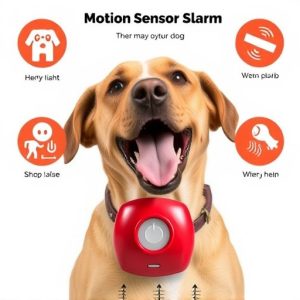Mastering Your Home’s Peace: A Guide to Motion Sensor Barking Dog Alarms
A motion sensor barking dog alarm is a versatile security device that effectively deters intruders …….
A motion sensor barking dog alarm is a versatile security device that effectively deters intruders and unauthorized pet movements by emitting realistic canine barking sounds. This alarm is designed to operate silently until motion is detected within its range, minimizing false alarms and ensuring privacy. It offers customizable settings for different zones and motion sensitivity, making it adaptable to various environments and household needs. For homeowners, it serves as a non-intrusive security measure that complements overall home security strategies. When selecting this device, consider its adjustable sensitivity, detection range, sound settings, durability, weatherproofing, and advanced features like night vision capabilities for optimal performance. It can also be integrated into pet training routines to address excessive barking by conditioning pets to associate the alarm's activation with cessation of the behavior, thus contributing to a more peaceful home environment. This device is an essential tool for anyone looking to balance security and tranquility within their household.
Navigating the challenges of pet-related disturbances can be a routine concern for homeowners. A motion sensor barking dog alarm stands as a modern solution, deterring unwanted canine activity and safeguarding tranquility. This article delves into the necessity of such an alarm, its pivotal features, and optimized installation strategies to ensure it operates at peak efficiency. We’ll also guide you through personalizing settings for your specific needs and offer insights on enhancing the device’s effectiveness in conjunction with pet training methods. Whether you’re dealing with a particularly vocal pup or simply seeking peace of mind, this piece is tailored to help you make informed decisions about your motion sensor barking dog alarm selection.
Understanding the Necessity for a Motion Sensor Barking Dog Alarm
When unplanned canine visits become a recurring issue, a motion sensor barking dog alarm serves as an invaluable tool for homeowners and property managers alike. This sophisticated device is designed to detect motion within a specified area, promptly activating an alarm that emulates the distinctive bark of a dog. The realistic imitation of a barking dog not only startles the intruder but also deters potential trespassers as it signals their presence to both the occupants and any actual canine companions on the premises. This deterrent effect is particularly potent, as the sound of a barking dog is inherently attention-grabbing and can be unsettling to those unfamiliar with the property.
The practicality of integrating such an alarm system cannot be overstated, especially for individuals who value privacy and security without the need for constant surveillance. The motion sensor barking dog alarm acts as a silent guardian, activating only when movement is detected, thus avoiding the inconvenience of false alarms triggered by mere noises or environmental changes. Its selective activation ensures that it responds appropriately to actual intrusions, providing homeowners with peace of mind and a reliable layer of security against unauthorized access. With its ability to be tailored to different zones and motion sensitivity levels, this alarm system is a versatile solution for any household vulnerable to canine-related disturbances or in need of a robust security measure.
Key Features to Consider When Choosing a Motion Sensor Barking Dog Alarm
When selecting a motion sensor barking dog alarm, it’s crucial to evaluate several key features that will determine its effectiveness and suitability for your specific needs. Firstly, consider the detection range and sensitivity settings of the device. A reliable model should have adjustable sensitivity to distinguish between casual barking and persistent or threatening noise, ensuring that it activates only when necessary. The detection range ought to be adequate to cover the areas you wish to protect without being overly sensitive to distant noises. Additionally, the alarm should offer customizable sound settings, allowing you to choose the volume and type of alert that suits your environment best. A versatile alarm can emit a variety of sounds, from a simple audible warning to a loud siren, which can be crucial in deterring potential intruders.
Furthermore, durability and weatherproof design are important considerations for an outdoor motion sensor barking dog alarm. The device should be built with sturdy materials that can withstand various environmental conditions without compromising its functionality. Look for models with a robust construction and water-resistant features to ensure they maintain their performance regardless of the weather. Advanced models may also incorporate night vision capabilities, enabling them to detect motion even in low-light conditions. Lastly, user-friendliness is another vital aspect; a model that is easy to install and operate will save you time and effort, and some systems come with remote control features for added convenience. Always ensure the alarm system you choose aligns with your specific requirements and complements your home security setup effectively.
Installation and Placement Strategies for Optimal Performance
When implementing a motion sensor barking dog alarm for effective pet deterrence, careful consideration must be given to both installation and placement strategies to ensure optimal performance. Typically, these alarms are equipped with advanced motion sensors that can detect movement within a specified range, making them ideal for securing sensitive areas without the need for continuous surveillance. To maximize their efficacy, the alarm should be installed at a height that prevents pets from tampering with it while ensuring that the sound is audible throughout the space it’s meant to protect. The ideal position often involves placing the device on a wall or shelf within a clear line of sight and away from corners where movement may be less detectable. It’s also crucial to consider the alarm’s range; positioning it too close to the entry point might result in false alarms, while placing it too far away could compromise its protective capabilities. For areas with multiple entry points, strategically installing multiple units can create a comprehensive security network that responds only to unauthorized motion, effectively deterring pets from accessing off-limits spaces without causing unwarranted disturbances. Regularly testing the alarm post-installation is key to confirming its functionality and ensuring it operates as intended when encountered by an intruder, be it a mischievous pet or an uninvited guest.
Customizing Settings: Tailoring Your Motion Sensor Barking Dog Alarm
When it comes to safeguarding your peace against canine disturbances, the motion sensor barking dog alarm stands as a robust solution. This advanced device is equipped with customizable settings that cater to the unique dynamics of your environment. Homeowners can fine-tune its sensitivity to distinguish between harmless canine chatter and persistent, intrusive barking that warrants an alert. By adjusting the sound level threshold, users can ensure the alarm activates only when the decibel levels reach a point where tranquility is disrupted. Additionally, the settings allow for the definition of motion detection zones, ensuring that the alarm responds to movement in specific areas rather than triggering indiscriminately. This targeted approach means that you can protect your privacy and rest undisturbed while still being alerted to genuine security concerns or unexpected guests. The ability to tailor the alarm’s responsiveness not only enhances its effectiveness but also integrates seamlessly into daily life, differentiating it from a one-size-fits-all approach. With these customizable features, the motion sensor barking dog alarm becomes an indispensable tool for maintaining a serene living space.
Maximizing Effectiveness: Training Your Pet with the Motion Sensor Barking Dog Alarm
Integrating a motion sensor barking dog alarm into your pet training regimen can significantly enhance its effectiveness, particularly when addressing unwanted behavior such as excessive barking. The device is designed to activate with precise motion detection, simulating the sound of a barking dog, which serves as an auditory cue for your pet. To maximize the benefits of this alarm, it’s crucial to condition your pet to associate the sound with the desired outcome. Begin by introducing the alarm under controlled conditions, ensuring your pet makes the association between the barking sound and the context in which it should cease barking. Gradually increase the exposure as your pet demonstrates understanding and response to the cue. Consistency is key; regular, positive reinforcement when your pet remains quiet after the alarm activates will help solidify the learning process. Additionally, adjust the sensitivity settings on the motion sensor barking dog alarm to match the range of motion that typically precedes unwanted barking in your pet. This tailored approach ensures the alarm functions as a reliable deterrent without causing undue stress or fear.
Furthermore, integrating the motion sensor barking dog alarm into a comprehensive training plan can address not only excessive barking but also serve as a versatile tool for various behavioral challenges. By placing the device strategically in areas where unwanted behaviors tend to occur, you can create an environment that encourages positive choices. It’s important to combine this technology with clear commands and consistent reinforcement of good behavior. The motion sensor barking dog alarm is most effective when used as part of a broader training approach, which may include desensitization exercises, obedience training, and environmental management. By doing so, pet owners can enjoy the benefits of a well-trained companion while ensuring that the alarm serves as an aid rather than a sole solution to behavioral issues.


